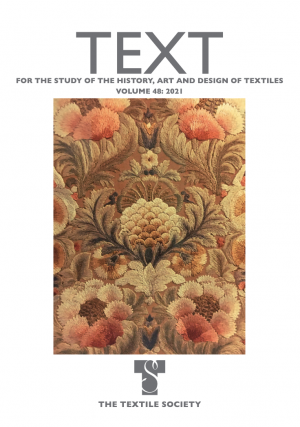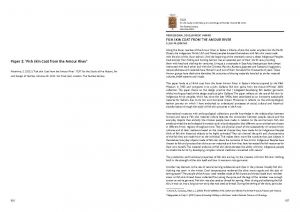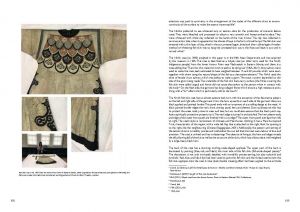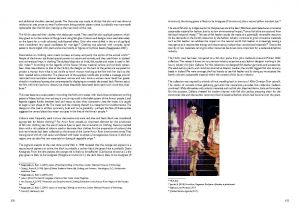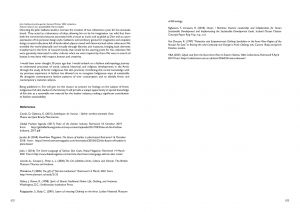Palomino, E. (2021) Fish Skin Coat from the Amur River. TEXT for the Study of the History Art Design of Textiles. V. 48: 2021. The Textiles Society, Pat Frost (ed)
Along the lower reaches of the Amour River, in Eastern Siberia, where the water empties into the Pacific
Ocean, the indigenous Nivkh, Ulch and Nanai peoples dressed themselves with fish skin coats made
with the skin of the chum salmon. Until the beginning of the twentieth century, these Indigenous Peoples
lived entirely from fishing and hunting. Salmon was an essential part of their world view, providing
them with food and clothing for centuries. Living at a crossroads in East Asia, these groups have always
interacted with each other and with the Chinese, Manchu, Koreans, Japanese and Russians. Imagination, resourcefulness, and materials have flowed in and out of their homeland for thousands of years. These Amour groups have distinctive identities. Yet centuries of sharing materials have led to similar material cultures, belief systems and rituals.
This paper looks at a Nivkh coat from the lower Amour River in Eastern Siberia acquired by the V&A
Museum in 1905 and compares it to a John Galliano fish skin parka from the Autumn/Winter 2002
collection. The paper draws on the design practice that I instigated developing fish leather garments
whilst working as head of the design studio at John Galliano. The paper reflects on the use of fish skin by Indigenous Arctic peoples, which has, since the late 1990s, been assimilated as an innovative sustainable material for fashion, due to its low environmental impact. Moreover, it reflects on the anthropological fashion journey on which I have embarked to understand processes of social, cultural and historical transformation through the study of fish skin practices in the Arctic.
International museums with anthropological collections provide knowledge in the relationships between
humans and nature. Fish skin material culture features the connection between people, nature and the
everyday objects that embody the choices people have made in relation to the environment. Fish skin
artefacts reveal the technological innovation and cultural adaptation that different communities have chosen in different Arctic regions throughout time. They are physical proof of the sustainability of various Arctic cultures and of their resilience based on the material choices they have made. Arctic Indigenous Peoples think of fish skin historical objects to be highly animated. They can channel the spirit and characteristics of the fish they are made from to the individual. This makes them more like conduits than just objects in themselves. Everyday objects made of fish skin share the narrative of how Arctic Indigenous Peoples have chosen to fish and process their skins as raw materials and how they have harvested the fish resources for their own benefit. The material evidence of fish skin demonstrates the ability of Arctic indigenous people to inhabit the Arctic by developing complex cultural traditions connected with nature.
- Palomino, E., Pardue, J., Donkan, A. (2023) Fish skin Peoples of the Bering Strait: Encounters in Hokkaido, Japan. Smithsonian Institution National Museum of natural History. Arctic Studies Center Newsletter. May 2023. N.30. pp.74-75
- Palomino, E. (2022) Indigenous Arctic Fish Skin Heritage: Sustainability, Craft and Material Innovation. PhD Thesis. University of the Arts, London.
- Palomino, E., Cloud, J. (2022) The Arctic as viewed from Florence. Arctic Studies Center Newsletter, Smithsonian National Museum of Natural History.
- Palomino, E. (2021) Fish Skin Coat from the Amur River. TEXT for the Study of the History Art Design of Textiles. V. 48: 2021. The Textiles Society, Pat Frost (ed)
- Trachter, F., Palomino, E., Defeo, G. (2021) Patagonian fish skin tanning processes. XXXVI IULTCS Congress Greening the Leather Value Chain
- Palomino, E., Pardue, J. (2021) Alutiiq Fish Skin Traditions: Connecting Communities in the COVID-19 Era. MDPI Heritage, 4, x. Academic Editor(s): Claire Smith.
- Palomino, E., Pardue, J., (2021) A virtual Alutiiq Fish Skin workshop during Covid-19 times. Smithsonian Institution National Museum of natural History. Arctic Studies Center Newsletter. May 2021. N.30.pp-16-17
- Palomino, E., Freilich, O., Raine, I. (2021) 'A virtual Ainu fish skin workshop during Covid 19'. Global Fashion conference. Academy of Fine Arts of Warsaw. ISBN: 978-989-54263-2-4
- Palomino, E., Karadottir, K. (2021) Fish skin, a historical material assimilated as a sustainable material for fashion. In: Fashion: Culture, Craft, and Identity. Brill.
- Palomino, E., Boon, J. (2020) Preservation of Hezhen Fish Leather tradition through Fashion Education. Textiles, Identity and Innovation. Taylor & Francis.
- Palomino, E. (2020) Fashion workshop in Anchorage. Smithsonian Institution National Museum of natural History. Arctic Studies Center Newsletter. May 2020. N.27.pp. 57-58
- Palomino, E., Karadottir, K., Phirry, E. (2020) Indigenous Fish Skin Craft Revived Through Contemporary Fashion. International Foundation of Fashion Technology Institutes Journal. ISSN: 2694-5193
- Palomino, E. Defeo, G. (2019) Material Design Research - Fish skin, a new environmental -friendly material for fashion. Design Research for Change. Design Museum, London ISBN 978-1-86220-369-3
- Palomino, E. Rahme, L. Karadottir, K. (2019) Indigenous Arctic Fish skin clothing traditions: Cultural and ecological impacts on Fashion HE. CUMULUS Conference Rovaniemi. ISBN 978-952-337-158-3.
- Palomino, E. (2019) SDG 14 Life Below Water Introducing Fish Skin as a Sustainable Raw Material for Fashion. In: Franco I., Chatterji T., Derbyshire E., Tracey J. (eds) Actioning the Global Goals for Local Impact. Science for Sustainable Societies. S
